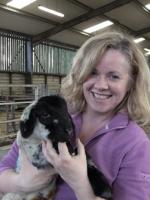Introduction
Animal welfare is a long standing and persistent societal concern over how livestock production methods affect the physical and mental well-being of farm animals. Improving animal welfare is dependent on developing reliable and valid welfare assessment techniques. In recent years animal welfare science has moved to studying what is referred to as ‘positive welfare’ which proposes that we should move beyond simply protecting animals from harms to ensuring that they have sufficient positive experiences such that overall farm animals have a net positive Quality of Life. The increasing interest in positive animal welfare is clearly reflected in policy; a key recommendation by Farm Animal Welfare Council (2009), and since reiterated by Scottish Government is that ‘All animals should have a life worth living and most animals should have a good life [in Scotland]’. The aspiration to improve positive welfare in Scottish livestock faces the challenges of understanding what is positive welfare for the different species that we farm, the cumulative effect of different negative and positive experiences across the animal’s life, and hence how to assess overall positive welfare and Quality of Life in farm animals. Furthermore, to promote the concept of positive welfare in farm animals requires that we have an understanding of the ‘demand’ for positive welfare in society and persuading the ‘supply chain’ that there is value in farm animals having a positive Quality of Life. This last aspect requires that, in addition to understanding positive welfare in the context of the animals’ experiences, we also seek to understand what human benefits may come from a greater focus on positive animal welfare in farm animals.
Aim of Research
To improve assessment of animal welfare in order to be able to characterise where animals are experiencing a net positive Quality of Life: Welfare of farmed livestock is an important ethical concern. Policy interest in the concept of 'positive welfare’ underlies our work. For this we aim to develop innovative welfare assessment techniques that improve our assessment of positive and negative welfare and overall Quality of Life. We also work on a better understanding of what positive welfare means biologically for different animal species and how different stakeholders understand what is meant by positive welfare.
Progress
2021 / 2022
Significant progress has been made against the original objectives. Several reports have been published developing the concept of positive animal welfare from natural and social science perspectives. These include a synthesis of the literature on a ‘Good Life’ for animals which in summary is somewhat undeveloped in the scientific literature and there remain important issues to be addressed if it is to be used to promote higher welfare standards in practice. This combined with a paper on the ‘Good Farmer’ identity has been used to develop a policy brief on best practice to facilitate a Good Life for animals in practice (A Good Animal Life: Bringing awareness of animal sentience into farming practice | SEFARI). A policy brief titled "Options for farm support payments for Animal Welfare in Scotland" has been produced. It reviews the different policy mechanisms for support payments to improve animal welfare being explored by Defra, Welsh and NI governments as well as EU. Experimental work has explored different aspects of positive welfare including effects of environmental enrichment and the presence of the mother for the first few weeks of life. A number of innovative approaches to welfare assessment have been developed and extended. The collaborative programme of practical roll out of Qualitative Behavioural Assessment with a major retailer was extended with another 6 supply chains (Beef cattle, Charcuterie Pigs, Goats, Sheep, Turkeys, Salmon), who were all trained in use of the QBA app and participated in video and farm trials as with the first 6 supply chains. There has been significant progress in the use of new technologies such as cameras and sensors to automate detection of welfare relevant behaviour- we published a paper showing that tail posture of pigs detected with 3D machine vision cameras can measure welfare on commercial farms, and won a Defra/Innovate UK project with agri-tech and pig industry partners to integrate 3D camera and volatile organic compound measures for early warning of pig diseases. There has also been highly successful outreach for example in relation to positive welfare, free farrowing and welfare and sustainability. Work on the interpretation of quantitative measures has directly contributed to guidelines on anthelmintic resistance testing to be adopted by the World Association for the Advancement of Veterinary Parasitology.
Highlights:
The QBA app which has been in development through the programme was the subject of a major award at the BBC’s Food & Farming Awards in November 2021. The award was presented to Waitrose and SRUC for the ground-breaking mobile application aimed at assessing emotional well-being of farm animals. https://waitrose.pressarea.com/pressrelease/details/78/NEWS_13/13572
A webinar focused on animal welfare and sustainability was held on 3rd March 2022. 400 registrations and 200+ participants were logged as being present. The recording is freely available via SRUC website https://vimeo.com/sruc.
A conceptual paper examining the similarities and differences between scientific and societal perspectives of positive welfare and what they may mean for future discussions of animal welfare has been published.
https://www.frontiersin.org/articles/10.3389/fanim.2021.738193/full.
An invited presentation on the positive and negative attributes of precision livestock farming techniques presented at the Swedish Veterinary Conference October 2021. 28/10/21: Technology and Ethics: https://www.svf.se/veterinarmedicin/veterinarkongressen/kongressen-2021/
Qualitative Behaviour Assessment. Managing emotional well-being in farm animals. Invited presentation at The European College of Animal Welfare and Behavioural Medicine. January 14th 2022.
Development of an app for delivering practical knowledge on enrichment provision in pigs and encouraging good-to-better practice of enrichment provision on pig farms. Platform (EdApp.com).
2020 / 2021
Our social science research has shown how stakeholders prioritise animal health and natural behaviours as key aspects of farm animal welfare. We have analysed our survey (conducted in year 4), to see how varying conditions of animal health (health issues minimised/ not minimised) and natural behaviour (natural behaviours promoted/ not promoted) influenced participants’ assessment of welfare. Animal health had the greatest impact on participants’ judgements of welfare, more than natural behaviours. However, participants considered welfare to be at its best when both health issues are minimised and natural behaviours promoted. The findings illuminate how and under what conditions stakeholders prioritise these two key aspects of farm animal welfare. In relation to maternal and neonate behaviour analysis of existing data, revealed that ewes modified their behaviour to increase expression of maternal care when litter size increased. Despite this the overall care received by individual lambs decreased with larger litters. These results suggest that the poorer survival of the lambs from larger litters is partially due to their own characteristics, such as slower behavioural development and lower body weight, and the inability of the ewe to deliver the same quantity of maternal care to larger litters. MRI analysis suggested that the presence or absence of maternal care did not affect the amount of grey matter (nerve cell bodies) in the brains of young lambs, which was affected primarily by age. This may suggest that this measure is not sufficiently sensitive to detect changes in behaviour, as differences in social behaviour and the rumen microbiome have been seen in this cohort of lambs. An experimental study to assess the impact on behaviour of rearing with or without the mother was initiated and will continue into 2021. The focus with work on Qualitative Behavioural Assessment (QBA) was the roll-out across supply chains (dairy cows, veal calves, pigs, laying hens, broilers, ducks) of a major UK retailer including the development and trialling of a mobile app for assessors. Supply chain teams developed their own lists of QBA descriptors and were given training in the use of the new QBA mobile app to apply these descriptors to livestock welfare assessment. All showed acceptable to good agreement using this tool in an online video-assessment exercise. Then on-farm roll-out of the app across supply chains was initiated, accompanied by a joined stakeholder/ SRUC press-release. This generated extensive media coverage (BBC1 Countryfile, radio interviews, over 60 UK/ international newspaper and website articles), and invitations to present QBA to the Farming All Party Parliamentary Group at Westminster Parliament and Defra. The importance of providing enrichment to promote positive welfare was investigated in sheep. Environmental enrichment promoted positive mental states. A study investigating cow preferences during lying showed that additional space for lying was prioritised over surface type in dairy cattle. Methods for automatic assessment of welfare have been developed; e.g. the sampling of volatile chemicals from cattle as a way of detecting disease and emotional state. Good quality rest and sleep is important for welfare, but traditionally, assessment of sleep has required fragile and expensive electrophysiological equipment. Proxy measures to assess sleep duration and quality were developed and assessed in dairy cattle. New guidelines using the non-inferiority framework to interpret anthelmintic resistance results have been developed.
Highlights:
An open access review of positive emotions and happiness in humans and animals has been published. https://www.sciencedirect.com/science/article/pii/S0149763420306801.
Two papers on the importance of natural behaviours and health to farmers and members of the public have been published in open access journals (farmers: https://www.frontiersin.org/articles/10.3389/fanim.2021.638782/full; members of the public: https://journals.plos.org/plosone/article?id=10.1371/journal.pone.0247788).
This year saw the start of the roll-out of a novel QBA mobile app across 6 supply chains of a major UK retailer, accompanied by substantial media coverage and presentations to the Farming All Party Parliamentary Group at Westminster Parliament and Defra.
A new EU Horizon 2020 grant (TechCare: Project – TechCare Project (techcare-project.eu)) began in September 2020 with SRUC as the coordinating institute, to consider welfare priorities for small ruminants, and how these can be managed by the use of technologies and Precision Livestock Farming approaches, building on previous RESAS and EU-funded projects.
A series of papers were published in open access journals outlining a Delphi approach to animal welfare prioritisation for farm animals, horses, companion animals and wildlife (farm animals: Frontiers | Prioritization of Farm Animal Welfare Issues Using Expert Consensus | Veterinary Science (frontiersin.org); horses: Animals | Free Full-Text | Determining a Welfare Prioritization for Horses Using a Delphi Method (mdpi.com); all species: Prioritisation of animal welfare issues in the UK using expert consensus - Rioja‐Lang - 2020 - Veterinary Record - Wiley Online Library).
2019 / 2020
A review of the literature on positive animal welfare (PAW) has identified the main themes which are represented in the PAW literature including positive emotions, positive emotions that result from performing motivated behaviour, Quality of Life and Happiness. In linked social science research a survey has been designed and disseminated to quantitatively assess societal perspectives on two key factors at the heart of debates on positive animal welfare; the minimisation of health issues and the promotion of natural behaviours. The findings will provide key insights into how different societal groups value these different elements of animal welfare and also highlight characteristics (e.g. socio-demographic factors) which may underlie different perspectives of positive animal welfare. Studies of maternal care in sheep revealed that young (adolescent) ewes had higher lamb mortality when rearing larger litters and expressed behaviours indicative of greater anxiety than older ewes, both during pregnancy and at lambing. Maternal separation (peer-rearing) affects relative volume of brain structures (by MRI) and social behaviour in lambs. Analysis of mite infestation in sheep revealed that treatment to kill the mites alone did not have an immediate impact on the clinical behavioural symptoms of discomfort (e.g. rubbing and scratching). However, if animals were also given an anti-inflammatory drug on the day of treatment these behaviours were significantly reduced indicating that treating inflammation as well as medication to kill the mites improved animal welfare. The passive state of lying with head low in dairy cows has been assessed using electrophysiological measurements, and the results suggest that this behaviour is an early stage of sleep. In QBA research there has been a focus on the analysis and evaluation of data gathered from the on-farm trialling of QBA scoring tools developed by stakeholders. Outcomes were presented to each stakeholder group for evaluation, and both groups agreed the use of QBA as a welfare assessment tool had provided new and relevant information about their animals’ welfare. The meaningful association of QBA data with herd health and productivity measures at one stakeholder’s 20 dairy farms was particularly welcomed as encouraging. QBA has also made a significant step towards commercial roll out through funding support for the QBA app and a contract with a commercial partner to use the app to assess and enhance positive welfare across its ‘own brand’ supply chains. In PLF related research different data modalities are being used to assess mastitis pain in cows, early detection of tail-biting in pigs, emotional state in pigs and overall welfare in poultry flocks. Generalizability Theory application continues with the aim of being used for population-oriented disease assessments.
Highlights:
An open public meeting entitled Raising the Bar on Positive Animal Welfare was held at The Roslin Institute Building and attended by students, government policy makers, non-government organisations and industry representatives. https://www.sruc.ac.uk/news/article/2544/raising_the_bar_on_positive_animal_welfare
Two members of the team working on 2.2.7 have been appointed to the Scottish Animal Welfare Commission (as Chair and Commissioner), which came into being on 26th June 2020
A paper on assessing positive welfare in ruminants was published in an Open Access Journal: https://www.ncbi.nlm.nih.gov/pmc/articles/PMC6826499/
A paper was presented at the UFAW Conference ‘Recent advances in animal welfare science VII’ on the welfare impacts of disease using the sheep cab as a model to illustrate how disease can have wider welfare implications on QoL: https://www.ufaw.org.uk/ufaw-events/recent-advances-in-animal-welfare-science-vii
An invited plenary address ‘Science and Sentience: assessing the quality of animal lives’ was presented to the 53rd ISAE congress in Bergen, Norway. https://www.applied-ethology.org/res/ISAE%202019%20Congress%20proceedings.pdf
We were granted an Animal Welfare Seeding Award by Newcastle University on behalf of the Biotechnology and Biological Sciences Research Council (BBSRC) and the Animal Welfare Research Network, in order to develop a mobile application for QBA data recording and analysis.
A chapter on QBA was published in a book aiming to provide pig farmers with practical approaches to assessing pig welfare on farms. https://www.5mbooks.com/pigs-welfare-in-practice.html
2018 / 2019
There has been significant progress in social and natural science studies of positive animal welfare including a review on assessing positive animal welfare taking account of research from animals and humans. Based on this a policy briefing summarising assessment of ‘happiness’ in animals has been published via the SRUC Rural Policy Centre and a number of national and international talks have been given. Scientific publications describing positive welfare have been completed including on environmental enrichment for pigs and the development of 'tickling' in rats as a model for the study of positive welfare in animals. An interview study to explore expert and lay-person understanding of positive animal welfare and factors influencing this has been published. This work has revealed divergent opinions on what positive welfare means both between and within farmers and citizens, set against a general lack of awareness of the term in both groups. Research on the role of maternal behaviour in positive welfare has illustrated the strength and importance of the ewe-lamb bond measured through behaviour and physiology, and international presentations of this work have been given. A study to explore the use of anti-inflammatory drugs to alleviate the symptoms of sheep scab alongside treatment to kill the scab mites has been completed. Further improvements in use of QBA for on-farm welfare assessment was successfully trialled by dairy farmers using a newly developed QBA app. In terms of work relating to automatic assessment of welfare there has been progress in using short video clips to assess both negative and positive states in cattle and very significant advances in the use of video recognition of tail-position as an early indicator of tail-biting. In addition major scientific funding has been won to use machine learning to assess emotionality it pigs via facial expressions. There has been significant progress in development of a sensor platform for assessing welfare in chicks and also in developing statistical approaches to interpretation of anthelmintic resistance test results.
Highlights:
- A major review of happiness and well-being in animals and humans has been written and used as the basis for policy briefings and a number of international talks on the biological basis of positive welfare in farm animals.
- A paper on farmer and citizens perceptions of positive animal welfare has been published. https://www.mdpi.com/2076-2615/9/4/147
- The use of video recognition of tail-posture as an early warning system for tail-biting in pigs has won further funding to take the approach a step further to practical implementation. https://www.gov.uk/government/publications/innovate-uk-funded-projects
- The use of sensors to continually record a range of welfare measures including feather condition and vocalisations has been further validated under farm conditions.
- A paper will be presented at the ICAR (International Committee for Animal Recording) Congress outlining results of a global survey on the welfare indicators used by organisations across the world. There were responses from 48 groups across 26 countries. Lameness, body condition score, cleanliness and diarrhoea were the most commonly scored. However, temperament and other behaviours were also used in a number of schemes.
2017 / 2018
Progress has been made on understanding positive welfare from both a scientific and a social science perspective, which is indicating divergent views between farmers and consumers. In sheep, our work is continuing on analysing maternal behaviour as a positive influence on offspring welfare, on characterising the responses of ewes to their lambs being in pain and on the use of behaviour as an early indicator of welfare state following infestation with sheep scab mite, which leads to major irritation of the skin. Working with industry partners, QBA tools for on-farm welfare assessment were developed and tested, with dairy farmers showing excellent agreement in their assessments of cow emotional expression. Work on use of facial images to discriminate pain states has been able to discriminate between lame and non-lame cows, although our research also suggested that video-images may allow better detection of pain than still images. Automatic recognition of low tail posture as an early indication of tail biting behaviour in pigs has moved from proof of concept to work with commercial partners. Analysis of sensors in poultry commercial farms has focused on the use of acoustic recordings as a welfare indicator. Further progress has been on developing statistical approaches to interpretation of anthelmintic resistance test results.
Highlights:
- A motion was raised in the Scottish Parliament to congratulate Scottish animal welfare scientists for international awards at the Congress of the International Society for Applied Ethology the main forum for animal behaviour and welfare scientists internationally. http://www.parliament.scot/parliamentarybusiness/28877.aspx?SearchType=Advance&ReferenceNumbers=S5M-07396
- Collaborations were formed and funding secured between scientists and technology companies to develop technologies such as video recognition and sensors as validated animal welfare assessment tools.
- A review of positive welfare exploring the origins and benefits of the approach was published as a book chapter and presented at several scientific and public meetings. https://www.sciencedirect.com/science/article/pii/B9780081010129000149
- A paper on the use of behavioural economic techniques to close the consumer attitude-behaviour gap with respect to animal welfare was published.
- A paper on QBA welfare assessment methodology was presented as the opening keynote address at a major international conference (Measuring Behaviour) in Manchester. https://www.measuringbehavior.org/files/2018/MB2018%20Proceedings.pdf
- New collaborations have been developed to support two new PhD students who will address aspects of mother-offspring behaviour to provided added value to this area of work.
2016 / 2017
This work maintains and develops a long-standing Scotland-based research capability in the assessment of farm animal welfare across all of the major farmed species. As examples of continuity of research we are studying ewe and lamb behaviour with a focus on the contribution of nurturing behaviour of the ewe to the positive welfare of both mother and offspring. In terms of assessing the impact of negative challenges we continue to study how to assess the impacts of disease on welfare, using sheep scab as a model. We also continue to develop the use of Qualitative Behavioural Assessment (QBA), originally developed through previous Scottish Government-funded research, as a practical on-farm welfare assessment technique. In terms of additions to our research portfolio we are studying the scientific basis of positive welfare and using social science to ask what farmers and citizens understand of positive welfare. We are also studying how various technologies such as video recognition and sensors can be used and validated to assess welfare under practical farm conditions.
Highlights:
- To recognise world Animal Welfare Day an open public meeting was held at The Roslin Institute Building and attended by over 200 students, government policy makers, non-government organisations and industry representatives.
- A paper on current scientific understanding of the emotional bonds that develop between mother and infants and the implications for farmed livestock was presented at a major international congress (ISAE: Denmark). https://www.applied-ethology.org/ISAE_Meetings.html
- Industrial partners including a major retailer were recruited to trial the use of our QBA welfare assessment approach on farms including the use of a QBA app.
- Joint work with Artist in Residence (Andrea Roe – Edinburgh College of Art) on pig play and exploration was shown at the Museum of English Rural Life (MERL). https://merl.reading.ac.uk/event/the-pig-park/
Future Activities
Work continues on different elements of positive animal welfare aimed at a better understanding of how the concepts of a ‘good life’ for animals and the ‘good farmer’ relate to the improvement of animal welfare. Further work on automated detection of behaviours such as play will be carried out with the aim of facilitating welfare assessment on commercial farms. The research work on the impact of the presence of the mother in the first few weeks of life for sheep will evaluate how this effects lamb play, social interactions, fearfulness and cognitive function. This will be achieved through a series of focused tests, and assessment of behavioural and physiological responses of lambs raised as a peer group or with the dam. Sustainable and ethical farming practices are key to the future developments of animal agriculture. How animal welfare interacts with sustainability and food production will be explored through discussion and debate to provide an opinion on future developments.
Selected Outputs
- Alexander, R., Aragón, O. R., Bookwala, J., Cherbuin, N., Gatt, J. M., Kahrilas, I. J., Kästner, N., Lawrence, A., Lowe, L., Morrison, R. G., Nusslock, R., Mueller, S. C., Papadelis, C., Polnaszek, K. L., Richter, S. H., Silton, R. L. and Styliadis, C. (2020) The Neuroscience of Positive Emotions and Affect: Implications for Cultivating Happiness and Wellbeing,” Neuroscience & Biobehavioral Reviews, https://doi.org/10.1016/j.neubiorev.2020.12.002. This review explores the biological basis for positive emotions and happiness in humans and animals.
- Größbacher, V., Lawrence, A. B., Winckler, C. and Špinka, M. (2020) “Negative play contagion in calves,” Scientific Reports, https://doi.org/10.1038/s41598-020-78748-7. This paper is the first to report that calves that play less can inhibit play in their pen-mates described as a negative contagion effect.
- Cooper, R., Wemelsfelder, F. 2020. Qualitative Behaviour Assessment as an indicator of animal emotional welfare in farm assurance. Livestock 25 (4), 2-5. http://dx.doi.org/10.12968/live.2020.25.4.180. This paper reviews the strong and vulnerable aspects of applying QBA as a practical indicator for emotional well-being in farm assurance.
- Duthie, C-A., J. M. Bowen, J.M., Bell, D. J., Miller, G. A., Mason, C. and Haskell, M. J. (2021). Feeding behaviour and activity as early-indicators of disease in pre-weaned dairy calves. Animal: 15 (3) 100150. https://doi.org/10.1016/j.animal.2020.100150. This paper showed that data from automated monitoring systems can detect illness in calves.
- Hunter, L.B., O’Connor, C., Langford, F.M., Haskell, M.J Stafford, K.J., Webster, J.R. (2021). Machine learning prediction of sleep stages in dairy cows from heart rate and muscle activity measures. Scientific Reports. 11(1):10938. doi: 10.1038/s41598-021-90416-y. This paper showed that sleep can be detected using heart rate monitors and muscle activity monitors, without EEG.
- Masłowska, K., Mizzoni, F., Dwyer, C.M., Wemelsfelder, F. 2020. Qualitative behavioural assessment of pain in castrated lambs. Applied Animal Behaviour Science 233 105143. https://doi.org/10.1016/j.applanim.2020.105143. This study is the first to apply QBA to the assessment of pain in farm animals.
- Rioja-Lang, F.C., Bacon H.J., Connor M., Lawrence, A.B., Dwyer C.M. (2020) Prioritisation of Farm Animal Welfare Issues in the UK Using Expert Consensus. Frontiers in Veterinary Science 6, article 495. https://doi.org/10.1136/vr.105964. This paper applies a Delphi method to deriving a consensus on the priority welfare issues for farmed animals.
- Rioja-Lang, F.C., Connor M., Bacon H.J., Dwyer C.M. (2020) Determining a welfare prioritization for horses using a Delphi method. Animals 10, 647. https://doi.org/10.3390/ani10040647. This paper considers the most important welfare issues for horses in the UK, derived from a Delphi expert consensus approach.
- Rioja-Lang, F.C., Bacon H.J., Connor M., Dwyer C.M. (2020) Prioritisation of animal welfare issues in the UK using expert consensus. Veterinary Record https://doi: 10.1136/vr.105964. This paper provided a welfare prioritisation for the most commonly managed domestic animal species in the UK, using expert consensus, and addressed cross-cutting issues of particular importance to animal welfare.
- Shewbridge Carter, L., Rutter, S.M., Ball, D., Gibbons, J. and Haskell, M.J. (2021). Dairy cows trade-off preference for two different lying qualities: lying surface vs. lying space. Journal of Dairy Science: 104 (1) 862-873. https://doi.org/10.3168/jds.2020-18781. This paper found that cows prioritise additional space for lying rather than a comfortable surface.
- Souza, A.P.O., Wemelsfelder, F., Taconeli, C.A., Molento, C.F.M. 2021. Development of a list of terms in Brazilian Portuguese for the Qualitative Behaviour Assessment of broiler chickens. Animal Welfare 30, 49-59. https://doi.org/10.7120/09627286.30.1.049. This study reports the first instance of developing a QBA descriptor list in a language other than English.
- Stephenson, E. and Haskell, M.J. (2020) The Use of a “Go/Go” Cognitive Bias Task and Response to a Novel Object to Assess the Effect of Housing Enrichment in Sheep Ovis aries), Journal of Applied Animal Welfare Science, DOI: 10.1080/10888705.2020.1824786. This paper reports that enrichment creates a positive emotional state in sheep.
- Vigors, B., Ewing, D.A., Lawrence, A.B., 2021. Happy or healthy? How members of the public prioritise farm animal health and natural behaviours. PLOS ONE 16, e0247788. https://doi.org/10.1371/journal.pone.0247788
- Vigors, B., Ewing, D.A., Lawrence, A.B., 2021. The Importance of Farm Animal Health and Natural Behaviors to Livestock Farmers: Findings From a Factorial Survey Using Vignettes. Front. Anim. Sci. 2. https://doi.org/10.3389/fanim.2021.638782
- McGrath et al., (2017) Hens vary their vocal repertoire and structure when anticipating different types of reward. Animal Behaviour. This study demonstrated that positive emotional states can be distinguished by vocal responses in hens, and may act as a novel welfare indicator for positive welfare.
- Richmond et al., (2017) Evaluation of animal-Based indicators to Be Used in a Welfare assessment protocol for sheep. Frontiers in Veterinary Science. This paper considered the validity, feasibility and reliability of putative welfare indicators for positive and negative welfare in sheep to develop a comprehensive welfare assessment protocol for sheep.
- Hintze et al., (2017) Qualitative Behaviour Assessment of horses exposed to short-term emotional treatments. Applied Animal Behaviour Science. An important new validation study showing people can accurately detect short-term fluctuations in horse expressions through use of QBA.
- Lahrmann et al., (2017) More tail lesions among undocked than tail docked pigs in a conventional herd. Animal. Refereed paper showing that tail docking is effective at preventing tail biting, and that even well managed commercial farms should not stop tail docking without first improving housing.
- Dwyer (2017) Reproductive management (including impacts of prenatal stress on offspring development). In ‘Advances in Sheep Welfare’, (ed. D.Ferguson, C.Lee, A. Fisher), Elsevier. Book chapter which highlights the importance of maternal care for offspring development.
- Boissy, et al., (2017) Fear. In ‘Animal Welfare’ (ed. M. Appleby, A. Olsson & F. Galindo), 3rd Edition, CAB International, Oxon, UK. Book chapter which investigates the impact of negative emotions, fear, on animal welfare and explores opportunities to mitigate fear, including through maternal care.
- Spinka and Wemelsfelder (2017). Environmental challenge and animal agency. In ‘Animal Welfare’ (ed. M. Appleby, A. Olsson & F. Galindo), 3rd Edition, CAB International, Oxon, UK. Book chapter which investigates the need of animals to actively engage with and learn about their environment.
- Lawrence and Baxter (2017). Sustainable Pig Production: Finding Solutions and Making Choices; Book Chapter in The Meat Crisis: this chapter highlights the wider importance of finding sustainable solutions to farming of pigs.
- Brown et al., (2018). Environmentally enriched pigs have transcriptional profiles consistent with neuroprotective effects and reduced microglial activity. Brain Behaviour Research. This paper for the first time indicates the beneficial effects of environmental enrichment on brain health in pigs.
- Vigors (2018). Reducing the Consumer Attitude–Behaviour Gap in Animal Welfare: The Potential Role of 'Nudges'. Animals.
- Members of the public state a desire for higher animal welfare but often fail to act on this as consumers, in response, this paper introduces how to address this issue through the use of psychologically relevant policy and behaviour change tools called nudges.
- De Boyer des Roches et al., (2018). Dairy cows under experimentally-induced Escherichia coli mastitis show negative emotional states assessed through Qualitative Behaviour Assessment. Applied Animal Behaviour Science. This paper shows that an observer who was unaware that certain cows had been infected with E. Coli, could distinguish these cows from healthy ones using QBA, rating the sick cows as more lethargic and dejected.
- D’Eath et al., (2018). Automatic early warning of tail biting in pigs: 3D cameras can detect lowered tail posture before an outbreak. PLOS One. Proof of concept showing that machine vision could provide early warning of tail biting on farm.
- Sarout et al., (2018). Assessment of circadian rhythm of activity combined with random regression model as a novel approach to monitoring sheep in an extensive system. Applied Animal Behaviour Science. Concluded that circadian rhythm provided a better assessment of how sheep respond to environmental challenges than activity alone.
- Lawrence et al., (2018) Positive welfare: What does it add to the debate over pig welfare? Chapter in Advances in Pig Welfare. This chapter explores the origins of the positive welfare concept and its potential to make a difference to pig welfare.
- Vigors (2019). Citizens' and Farmers' Framing of 'Positive Animal Welfare'and the Implications for Framing Positive Welfare in Communication. Animals. This paper details the findings of an interview study of citizens’ and farmers’ perceptions of positive welfare and what this may mean for effectively communicating positive welfare to key stakeholders in society.
- Chou et al., (2019) Rearing Undocked Pigs on Fully Slatted Floors Using Multiple Types and Variations of Enrichment. Applied Animal Behaviour Science. This paper shows that it is possible to rear undocked pigs on slatted floors without much tail biting if plenty and diverse enrichment is used.
- Lawrence (2019). Positive animal welfare: From concept through research to practice. Presentation at the Swedish Centre for Excellence in Animal Welfare, Uppsala (Oral presentation) which summarised the development of the positive animal welfare (PAW) concept and how Paw might improve welfare in practice.
- Wemelsfelder (2019). Animals as Sentient Beings. Invited presentation at The Ethical Farming Conference in Scotland, discussing the meaning of the term ‘Sentience’ and its implications for how we farm animals.
-
Lawrence et al., (2019) What Is so Positive about Positive Animal Welfare?—A Critical Review of the Literature. Animals. This critical review aimed to distinguish the different aspects of positive animal welfare and to situate the concept in relation to the traditional animal welfare literature.
Birch, J., Broom, D.M., Browning, H., Crump, A., Ginsburg, S., Halina, M., Harrison, D., Jablonka, E., Lee, A.Y., Kammerer, F., Klein, C., Lamme, V., Michel, M., Wemelsfelder, F. and Zacks, O. 2022. How should we study animal consciousness scientifically? Journal of Consciousness Studies 29, 8–28. http://doi.org/10.53765/20512201.29.3.008.
Carter, L. S., Haskell, M. J., Ball, D., Gibbons, J., Harris, W. E., & Rutter, S. M. (2022). Dairy cows value an open area for lying down. PLoS ONE, 17(5), e0268238. Retrieved from https://doi.org/10.1371/journal.pone.0268238
Ceballos, M.C., Rocha Góis, K.C., Sant’Anna, A.C., Wemelsfelder, F. and Paranhos da Costa, M. 2021. Reliability of qualitative behavior assessment (QBA) versus methods with predefined behavioral categories to evaluate maternal protective behavior in dairy cows. Applied Animal Behaviour Science 236, 105263. https://doi.org/10.1016/j.applanim.2021.105263.
D’Eath RB, Foister S, Jack M, Bowers N, Zhu Q, et al. (2021) Changes in tail posture detected by a 3D machine vision system are associated with injury from damaging behaviours and ill health on commercial pig farms. PLoS ONE 16(10): e0258895. https://doi.org/10.1371/journal.pone.0258895
Hall, S.A., Farish, M., Coe, J., Baker, E., Camerlink, I., Lawrence, A.B. and Baxter, E.M., 2021. Minimally invasive biomarkers to detect maternal physiological status in sow saliva and milk. Animal, 15(11), p.100369.
Hansen, M.F., Baxter, E.M., Rutherford, K.M., Futro, A., Smith, M.L. and Smith, L.N., 2021. Towards Facial Expression Recognition for On-Farm Welfare Assessment in Pigs. Agriculture, 11(9), p.847.
Clarkson, J.M., Baxter, E.M. and Martin, J.E., 2021. Who plays with whom: farrowing environment influences isolation of foster piglets in play. Frontiers in Animal Science, p.45.
Johnson, A. K., Rault, J.-L., Marchant, J. N., Baxter, E. M., & O’Driscoll, K. (2022). Improving young pig welfare on-farm: The Five Domains Model. Journal of Animal Science. Retrieved from https://doi.org/10.1093/jas/skac164
Langford, B., Cash, J. M., Beel, G., Marco, C. D., Duthie, C.-A., Haskell, M J., … Nemitz, E. (2022). Passive breath monitoring of livestock: using factor analysis to deconvolve the cattle shed. Journal of Breath Research, 16(2), 026005. Retrieved from https://doi.org/10.1088/1752-7163/ac4d08
Mutua, E. K., & Haskell, M. J. (2021). Factors contributing to milk yield variation among cows in a cow–calf contact system in early lactation. JDS Communications, 3(1), 55–58. Retrieved from https://doi.org/10.3168/jdsc.2021-0143
Oldham, L., Arnott, G., Camerlink, I., Doeschl-Wilson, A., Farish, M., Wemelsfelder, F. and Turner, S.P. 2021. Once bitten, twice shy: Aggressive and defeated pigs begin agonistic encounters with more negative emotions. Applied Animal Behaviour Science 244, 105488. https://doi.org/10.1016/j.applanim.2021.105488.
Shaw, N., Wemelsfelder, F. and Riley, L. 2022. Bark to the future: The welfare of domestic dogs during interaction with a positively reinforcing artificial agent. Applied Animal Behaviour Science 249, 105595. https://doi.org/10.1016/j.applanim.2022.105595
Stephenson, E., & Haskell, M. J. (2020). The Use of a “Go/Go” Cognitive Bias Task and Response to a Novel Object to Assess the Effect of Housing Enrichment in Sheep (Ovis aries). Journal of Applied Animal Welfare Science, 25(1), 1–13. Retrieved from https://doi.org/10.1080/10888705.2020.1824786
Vigors, B., Sandøe, P. and Lawrence, A.B., 2021. Positive Welfare in Science and Society: Differences, Similarities and Synergies. Frontiers in Animal Science, 2, p.738193. https://www.frontiersin.org/articles/10.3389/fanim.2021.738193/full





